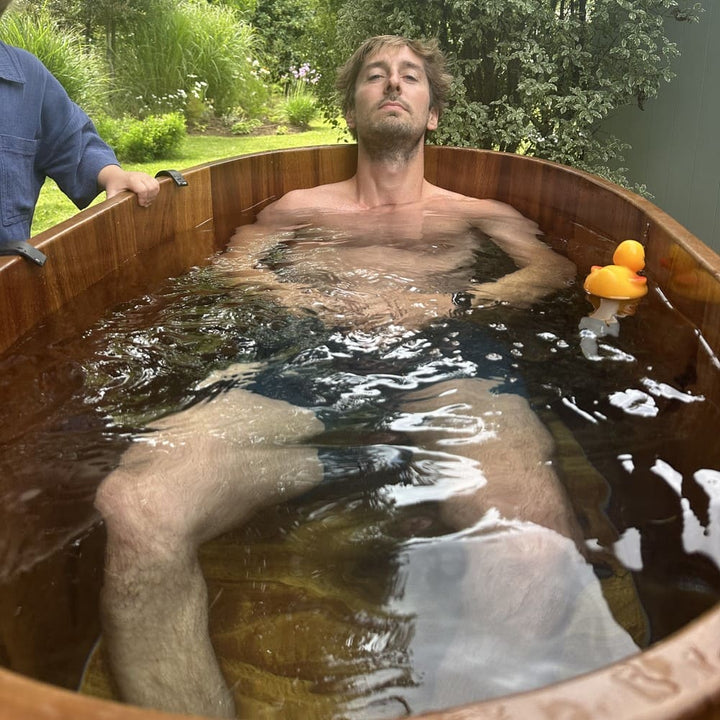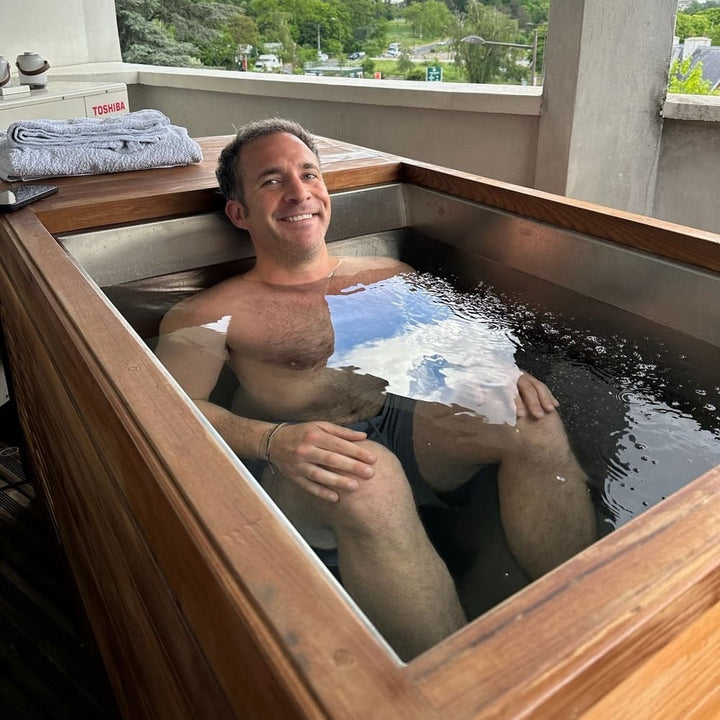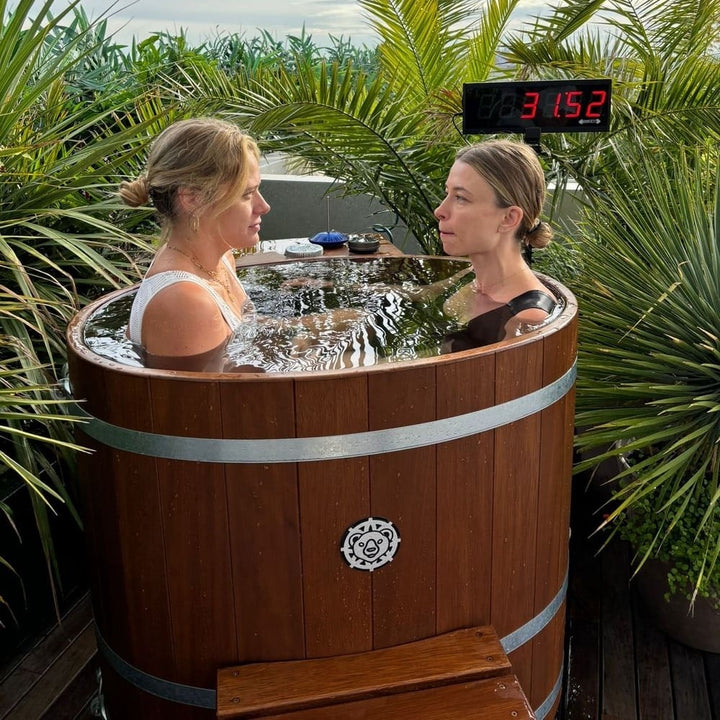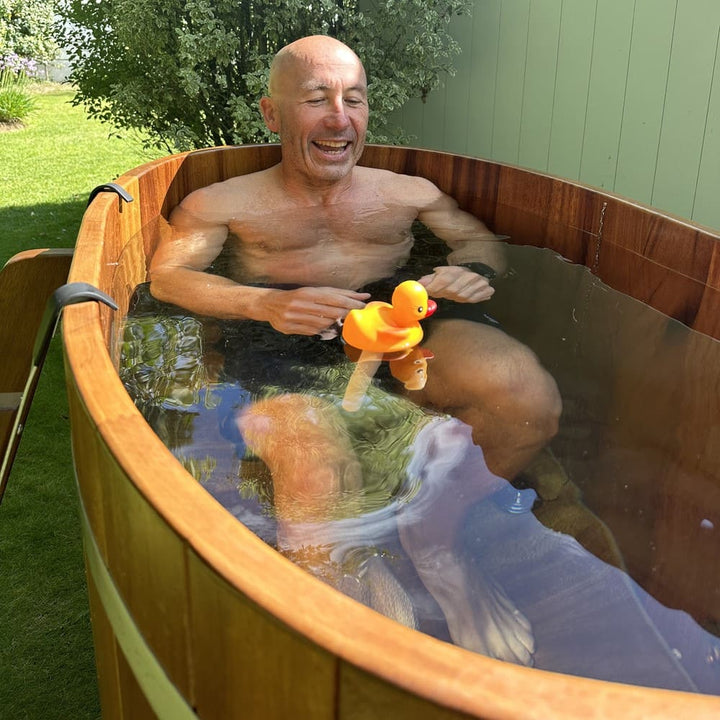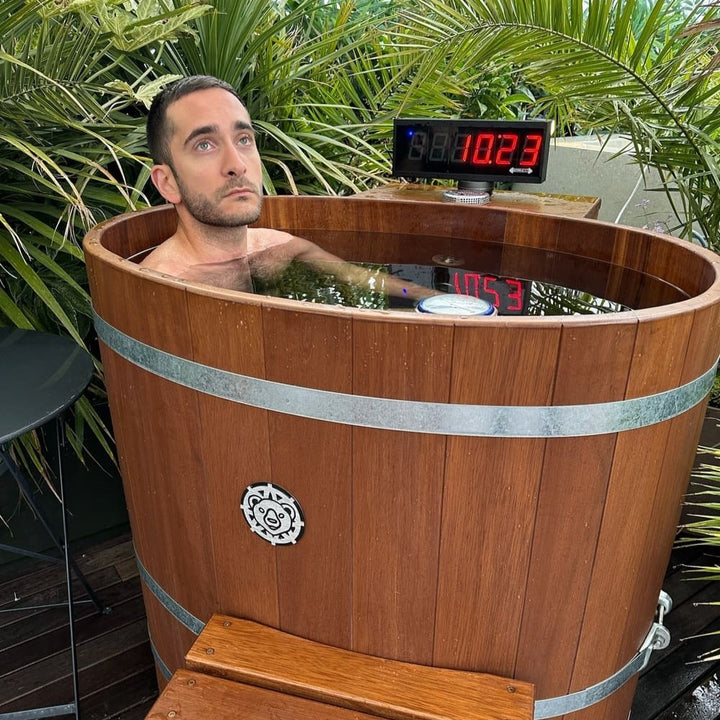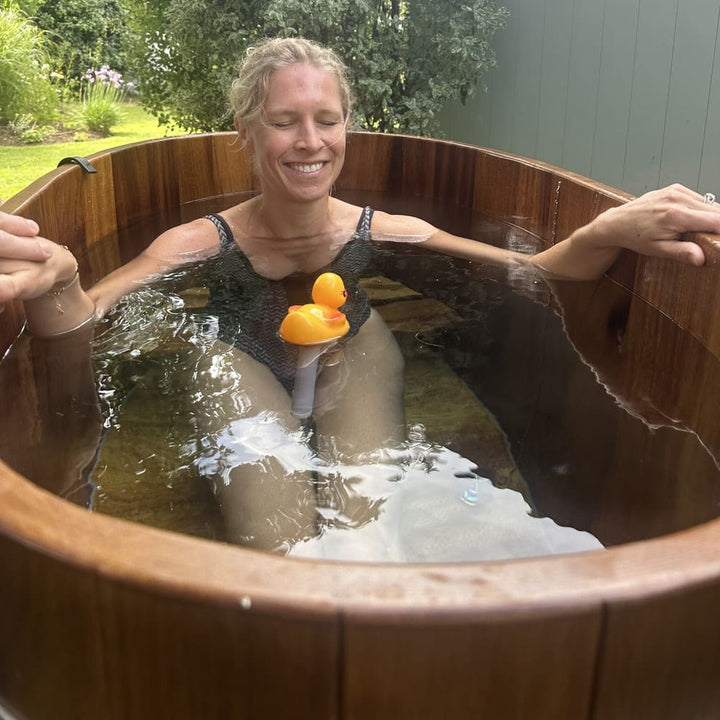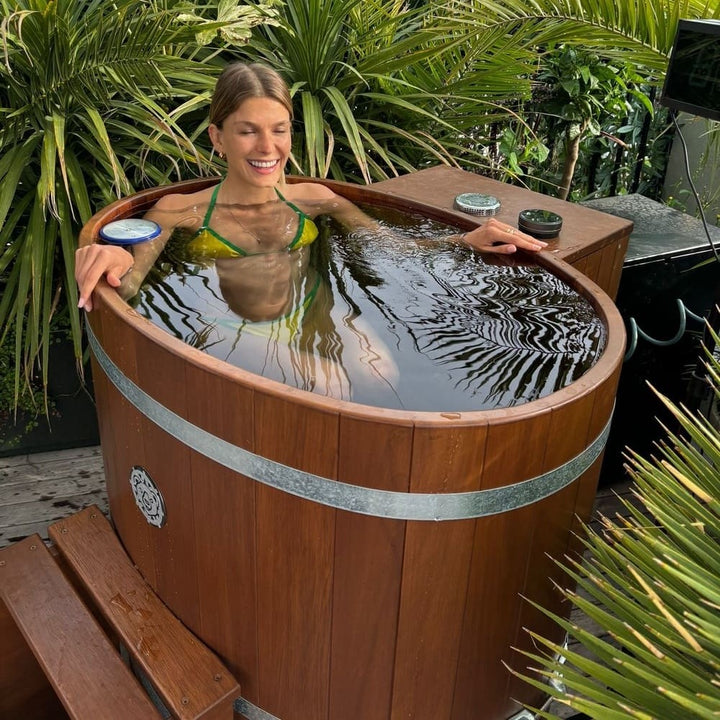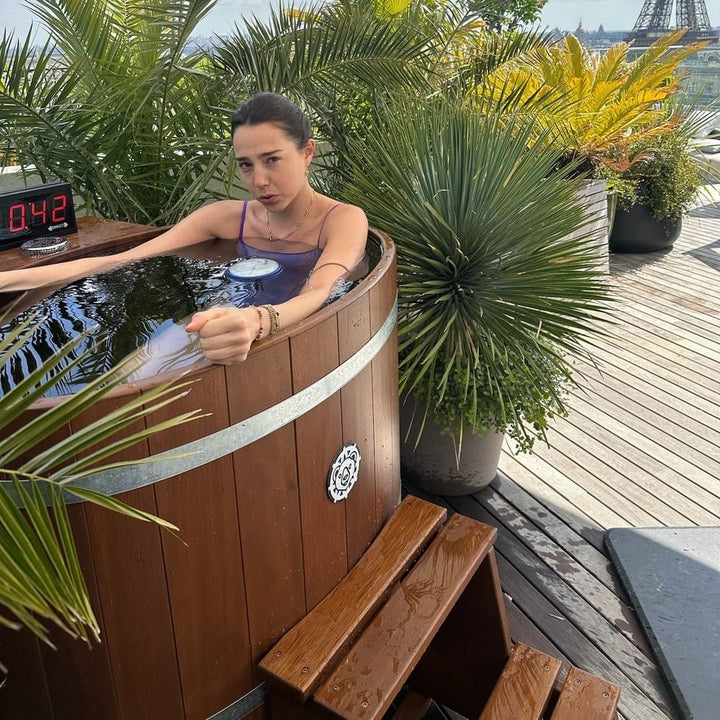The use of cold baths for therapeutic purposes has ancient roots. Historical records indicate that various ancient cultures, including the Greeks and Romans, practiced cold water immersion for health benefits. Hippocrates, the ancient Greek physician often referred to as the father of medicine, mentioned the use of cold water for pain relief and inflammation reduction. In different periods throughout history, cold baths were employed for their perceived healing properties. While the specifics of the practices varied, the concept of using cold water for therapeutic benefits has been present for centuries.
The use of cold plunges or cold therapies has gained popularity worldwide, particularly in countries where wellness and recovery practices are emphasized. Countries in Northern Europe, like Finland and Russia, have a long tradition of cold water immersion, often associated with sauna culture. Scandinavia, in general, has embraced cold water exposure as part of a holistic approach to health. Moreover, countries with a strong emphasis on sports and fitness, such as the United States, Canada, and Australia, have seen an increased interest in cold therapies among athletes and fitness enthusiasts. The use of cryotherapy chambers, ice baths, or cold plunges has become more common in wellness centers and sports facilities globally.
Deliberate cold exposure, such as cold water immersion or cryotherapy, can offer several benefits for both the body and the mind:
Benefits for the body:
1.Reduced Inflammation: cold exposure may help reduce inflammation, providing relief for conditions like muscle soreness and joint pain.
2.Enhanced Recovery: athletes often use cold therapies to accelerate recovery after intense physical activity by reducing muscle damage and soreness.
3.Improved Circulation: cold exposure can stimulate blood circulation, potentially improving overall cardiovascular health.
4.Boosted Immune System: cold exposure might contribute to a temporary boost in immune system activity, enhancing the body's ability to fight off illness.
Benefits for the mind:
1.Stress Reduction: cold exposure can trigger the release of endorphins, which are known as "feel-good" hormones, leading to stress reduction and an improved mood.
2.Increased Alertness: exposure to cold can increase alertness and mental clarity, possibly enhancing cognitive function.
3.Improved Mood: cold exposure has been associated with an increase in dopamine production, contributing to a positive mood and a sense of well-being.
4.Enhanced Resilience: regular exposure to cold conditions may help build mental and emotional resilience to stress and discomfort. It's important to note that while deliberate cold exposure can have benefits, individual responses vary. People with certain health conditions or sensitivities should consult with a healthcare professional before incorporating cold exposure into their routine. Additionally, moderation and gradual adaptation are key to a safe and effective practice.
Deliberate cold exposure can trigger the release of several hormones, each playing a specific role in the body's physiological response to cold stress. Some of the key hormones involved include:
1.Epinephrine (Adrenaline): released by the adrenal glands, epinephrine is a stress hormone that prepares the body for a "fight or flight" response. It increases heart rate, redirects blood flow to vital organs, and mobilizes energy reserves.
2.Norepinephrine: similar to adrenaline, norepinephrine is involved in the body's stress response. It helps increase alertness, focus, and energy mobilization.
3.Endorphins: cold exposure can stimulate the release of endorphins, which are the body's natural painkillers and mood enhancers. They contribute to a sense of well-being and can act as stress relievers.
4.Dopamine: cold exposure has been associated with increased dopamine production. Dopamine is a neurotransmitter linked to motivation, pleasure, and reward. Its release may contribute to improved mood.
5.Cortisol: while cortisol is often associated with stress, its release during cold exposure is a natural part of the body's adaptive response. It helps regulate metabolism, blood sugar, and immune function.
6.Thyroid Hormones (T3 and T4): cold exposure can stimulate the thyroid gland to release thyroid hormones. These hormones play a role in regulating metabolism and maintaining body temperature. The release of these hormones collectively orchestrates the body's response to cold stress, helping to increase alertness, mobilize energy, and adapt to the challenging environmental conditions. It's important to note that while these hormonal responses can have benefits, individuals with certain health conditions should approach deliberate cold exposure with caution and seek guidance from healthcare professionals if needed.
The benefits of deliberate cold exposure can vary from person to person based on individual factors, including genetics, overall health, tolerance to cold, and specific health goals. Here are some factors that contribute to individual variations in response to cold exposure:
1.Genetic Factors: genetic differences can influence how individuals respond tocold. Some people may naturally have a higher tolerance for cold temperatures or a more robust physiological response.
2.Adaptation: individuals who regularly expose themselves to cold conditions may experience a more robust adaptation over time. This adaptation can influence the extent of physiological responses and potential benefits.
3.Health Status: the health status of an individual plays a crucial role. People with certain medical conditions or compromised health may not experience the same benefits or could be at risk for adverse effects. It's essential to consider factors such as cardiovascular health, respiratory health, and any underlying medical conditions.
4.Personal Sensitivity: sensitivity to cold can vary widely among individuals. Some people may find cold exposure more challenging and may need to progress more slowly in their practices.
5.Goals and Expectations: the perceived benefits of cold exposure may also depend on individual goals. For instance, athletes seeking enhanced recovery or individuals aiming to manage stress may experience different outcomes based on their objectives. While some individuals may derive significant benefits from deliberate cold exposure, it's important to approach it with caution, especially for those with pre-existing health conditions. Consulting with a healthcare professional before incorporating cold exposure practices is advisable. Additionally, starting gradually and listening to one's body during the process is essential to ensure safety and effectiveness.
While deliberate cold exposure can have various benefits, it's important to be aware of potential risks, especially for certain individuals or under specific circumstances. Here are some potential risks associated with deliberate cold exposure:
1.Hypothermia: prolonged exposure to extremely cold conditions without adequate protection can lead to hypothermia, a dangerous condition where the body loses heat faster than it can produce it. This can result in a drop in body temperature, affecting organ function.
2.Frostbite: exposure to extreme cold can cause frostbite, which occurs when skin and underlying tissues freeze. Frostbite can lead to tissue damage and, in severe cases, may require medical attention.
3.Cardiovascular Stress:cold exposure can lead to an increase in blood pressure and heart rate. Individuals with cardiovascular issues should exercise caution, as the added stress on the heart may pose risks.
4.Respiratory Issues: individuals with respiratory conditions, such as asthma, may experience exacerbation of symptoms in response to cold air. Cold exposure may trigger bronchoconstriction and worsen respiratory discomfort.
5.Raynaud's Phenomenon: people with Raynaud's phenomenon, a condition affecting blood flow to certain parts of the body, may experience worsened symptoms with exposure to cold.
6.Increased Risk for Certain Populations: pregnant women, young children, and the elderly may have reduced tolerance to cold exposure. Special care is needed for these populations.
7.Individual Variability: people react differently to cold, and what may be a safe and comfortable exposure for one person could be uncomfortable or risky for another. Individual sensitivity varies widely. It's crucial to approach deliberate cold exposure with caution, especially for those with pre-existing health conditions. Before starting any cold exposure practices, individuals should consult with a healthcare professional to assess their suitability and receive personalized guidance. Practicing gradual adaptation and using proper safety measures, such as limiting exposure times, can help minimize potential risks.
Deliberate cold exposure is not recommended for certain individuals, especially those with specific health conditions or characteristics that may increase the risks associated with cold stress. Here are groups of people for whom deliberate cold exposure is generally not recommended or should be approached with caution:
1.Individuals with Cardiovascular Issues: those with heart conditions, high blood pressure, or a history of cardiovascular problems should exercise caution. Cold exposure can increase blood pressure and heart rate, potentially placing additional stress on the cardiovascular system.
2.People with Respiratory Conditions: individuals with respiratory conditions such as asthma or chronic obstructive pulmonary disease (COPD) may find that cold air exacerbates their symptoms. Cold exposure could trigger bronchoconstriction and breathing difficulties.
3.Individuals with Raynaud's Phenomenon: people with Raynaud's phenomenon, a condition that affects blood flow to certain parts of the body, may experience aggravated symptoms with cold exposure.
4.Pregnant Women: pregnant women should be cautious with deliberate cold exposure. Extreme cold conditions may pose risks, and changes in blood pressure and circulation can affect both the mother and the developing fetus.
5.Young Children: young children may have difficulty regulating body temperature, and their ability to communicate discomfort may be limited. Deliberate cold exposure should be avoided for young children or approached with great care.
6.Elderly Individuals:older adults may have reduced tolerance to extreme cold, and their bodies may not respond as effectively to temperature changes. The risk of hypothermia is higher in older populations.
7.Individuals with Compromised Immune Systems: those with weakened immune systems, due to conditions such as autoimmune disorders or immunosuppressive medications, may be more susceptible to illness following exposure to cold.
8.People with Open Wounds or Skin Conditions: individuals with open wounds, skin infections, or dermatological conditions
There isn't a strict minimum age for deliberate cold exposure, but caution should be exercised, particularly with young children. Children may have difficulty regulating their body temperature, and their response to cold stress may differ from that of adults. It's advisable to consult with a pediatrician or healthcare professional before introducing deliberate cold exposure to children. For older children or teenagers, gradual introduction to milder forms of cold exposure, such as shorter cold showers or cool water immersion, under parental supervision may be considered. It's essential to prioritize safety, monitor the child's comfort, and be responsive to any signs of distress or discomfort. As with any health-related practice, individual factors, including the child's health status and overall well-being, should be taken into consideration. Always seek guidance from a healthcare professional when introducing new wellness practices, especially for younger individuals.
Pregnant women should exercise caution when considering deliberate cold exposure, and it's advisable to consult with a healthcare professional before incorporating such practices into their routine. Extreme cold conditions or sudden changes in body temperature may pose risks during pregnancy. Cold exposure can potentially lead to increased stress on the cardiovascular system, and there may be concerns related to blood pressure and circulation. Additionally, the fetus relies on the mother's stable internal environment, and drastic changes in body temperature might impact the developing baby. If a pregnant woman wishes to explore cold exposure, it's crucial to discuss this with her healthcare provider. The healthcare professional can assess the individual's specific health status, consider any potential risks, and provide personalized guidance based on the pregnancy's unique circumstances. In general, pregnant women are encouraged to prioritize activities that promote overall well-being and are deemed safe during pregnancy. Always seek professional advice before engaging in practices that involve significant changes to physical conditions, especially when expecting.
When you're sick, particularly with the flu, using a cold plunge or exposing yourself to cold temperatures may not be advisable. Here's why:
1.Potential Stress on the Immune System: when you're sick, your immune system is already working hard to fight off the illness. Exposure to cold stress may add an additional burden to your immune system, potentially slowing down the recovery process.
2.Increased Discomfort: cold exposure can be uncomfortable, and when you're already dealing with flu symptoms such as fever, body aches, and chills, exposing yourself to cold temperatures might intensify these symptoms.
3.Risk of Hypothermia: illness can affect your body's ability to regulate temperature. Exposure to cold water or cold air might increase the risk of hypothermia, especially if you're already experiencing fever or have a compromised ability to maintain normal body temperature.
4.Dehydration Risk: illness can lead to dehydration, and exposure to cold conditions may increase fluid loss through mechanisms like shivering. It's crucial to stay well-hydrated when you're sick, and cold exposure may counteract hydration efforts. If you have the flu or another illness, it's generally recommended to prioritize rest, stay warm, and stay hydrated. If you're considering any unconventional therapies or practices, it's important to consult with a healthcare professional to ensure they won't interfere with your recovery process or worsen your symptoms.
Putting your hands under water in an ice bath is generally safe, and many people fully immerse themselves, including their hands, during cold exposure practices. However, it's crucial to be mindful of your own comfort and tolerance to the cold. Here are a few considerations:
1.Gradual Adaptation: if you are new to ice baths or cold exposure, consider starting gradually. Begin with shorter durations and monitor your body's response.
2.Sensitivity: hands and feet can be particularly sensitive to cold. Some individuals may find that their hands become uncomfortable or even painful in extremely cold water. If you experience discomfort, you can choose to keep your hands above the waterline or use gloves to protect them.
3.Listen to Your Body: pay attention to how your body responds during and after the cold exposure. If you experience extreme discomfort, numbness, or pain, it's important to exit the ice bath immediately.
4.Circulation: cold can cause vasoconstriction, narrowing blood vessels. Ensure that your hands do not become excessively cold to the point where it affects circulation. If you notice any signs of poor circulation (such as numbness or discoloration), take appropriate measures to warm up. Always consult with a healthcare professional before incorporating new wellness practices, especially if you have pre-existing health conditions or concerns. Remember that the key is to find an approach that works for you and to prioritize safety and comfort during cold exposure.
Putting your head under water in an ice bath can be done, but it's important to exercise caution and consider certain factors:
1.Breathing Control: when submerging your head, ensure that you can maintain control over your breathing. Cold water immersion can induce a gasp reflex, and it's crucial to avoid inhaling water.
2.Comfort and Tolerance: cold water exposure, especially to the head and face, can be intense. Some individuals may find it uncomfortable, and it's essential to listen to your body. If you feel overly distressed, consider keeping your head above water.
3.Gradual Adaptation: if you're new to ice baths, it's advisable to start gradually. Begin with shorter durations and progressively increase the time as your body adapts to the cold.
4.Safety Precautions:ensure that the ice bath is set up safely, and you have someone nearby or are in an environment where assistance is readily available if needed.
5.Medical Considerations: individuals with certain medical conditions, such as cardiovascular issues or respiratory problems, should consult with a healthcare professional before attempting prolonged cold exposure or submerging their heads. Always prioritize safety and comfort during cold exposure practices. If you have concerns or specific health considerations, it's best to seek advice from a healthcare professional before incorporating such practices into your routine.
Whether you should stay still or move your limbs in an ice bath can depend on your personal preference, comfort level, and the purpose of the cold exposure. Here are considerations for both approaches:
Staying Still:
1.Minimizes Heat Generation: Staying still helps minimize heat generation through physical activity, allowing the cold to have a more pronounced effect.
2.Enhances Cold Response: Remaining still may enhance the body's cold response, as movement generates heat and can counteract the cooling effects of the ice bath.
Moving Your Limbs:
1.Improved Circulation: Gentle movement, such as slow leg or arm movements, can help maintain blood circulation and prevent excessive vasoconstriction, which may occur with prolonged stillness.
2.Reduced Discomfort: Some people find that subtle movements can reduce discomfort by preventing stiffness or numbness in the extremities. Ultimately, the choice between staying still or moving your limbs in an ice bath depends on your goals and how your body responds. It's essential to pay attention to your comfort level and avoid pushing yourself too hard, especially if you are new to cold exposure practices. If you're using ice baths for recovery after exercise, some advocates recommend starting with stillness to allow the cold to penetrate, then incorporating gentle movements as you acclimate. Always prioritize safety, listen to your body, and, if you have any medical concerns, consult with a healthcare professional before incorporating ice baths into your routine.
Whether it's preferable to lie down or sit down in an ice bath depends on personal comfort and individual preference. Both positions have their advantages, and the choice often comes down to what feels better for you. Here are considerations for each:
Lying Down:
1.Full Immersion: lying down allows for a more complete immersion, ensuring that a larger portion of your body is in contact with the cold water.
2.Relaxation: some people find lying down more conducive to relaxation, as it allows them to fully extend and unwind.
Sitting Down:
1.Comfort: sitting down might be more comfortable for some individuals, especially if they find it challenging to lie down in a confined space or if they have back issues.
2.Easier Entry and Exit: getting in and out of the ice bath can be easier when sitting, providing more stability and control. Ultimately, there's no one-size-fits-all answer. You may want to experiment with both positions and see which one you find more comfortable and practical for your specific situation. Regardless of whether you choose to lie down or sit down, it's crucial to prioritize safety, pay attention to your body's signals, and adjust your practice accordingly.
Controlling your breath during an ice bath is crucial for managing the body's response to the cold stress. Here are some tips on how to control your breath effectively:
1.Deep Breaths: take slow and deep breaths. Inhale through your nose and exhale through your mouth. This deliberate breathing pattern can help calm the nervous system and reduce the body's stress response.
2.Maintain a Rhythmic Pattern: establish a steady and rhythmic breathing pattern. Consistency in your breath can help regulate your body's response to the cold.
3.Focus on Exhalation: pay particular attention to your exhalation. A prolonged and controlled exhale can signal to your body that you are relaxed, helping to manage stress.
4.Mindful Breathing: practice mindfulness by focusing your attention on your breath. This can help shift your focus away from the discomfort of the cold and promote a sense of calm.
5.Avoid Hyperventilation: while it's essential to breathe intentionally, avoid hyperventilating, as this can lead to a decrease in carbon dioxide levels in the blood, potentially causing dizziness or lightheadedness.
6.Progressive Adaptation: if you're new to ice baths, gradually increase your exposure time. This allows your body to adapt, and you can practice controlling your breath more effectively over time. Remember that everyone's tolerance to cold and breathing techniques may vary. Listen to your body, and if you experience any signs of discomfort or distress, adjust your breathing accordingly. If you have pre-existing health conditions, consult with a healthcare professional before incorporating ice baths or cold exposure into your routine.
Deliberate cold exposure can have various effects on blood pressure and blood circulation:
1.Vasoconstriction: exposure to cold typically induces vasoconstriction, the narrowing of blood vessels. This physiological response is the body's way of minimizing heat loss and conserving warmth. Vasoconstriction can temporarily increase blood pressure.
2.Blood Pressure Increase:cold exposure may lead to a temporary increase in blood pressure. This effect is more pronounced during exposure and tends to return to baseline levels after warming up.
3.Peripheral Blood Flow Reduction: cold exposure may reduce blood flow to peripheral areas, such as the skin and extremities, as the body prioritizes maintaining core temperature. This can contribute to cold-induced numbness or tingling in the extremities.
4.Centralization of Blood Flow: blood circulation may shift toward vital organs, concentrating on maintaining organ function in the core of the body. This can result in a centralization of blood flow.
5.Heart Rate Response: the heart rate often increases in response to cold exposure. This is part of the body's effort to pump more blood to maintain core temperature and support vital functions. It's important to note that these responses can vary among individuals, and factors such as the duration and intensity of cold exposure play a role. Individuals with pre-existing cardiovascular conditions should exercise caution and seek advice from a healthcare professional before engaging in deliberate cold exposure practices. Regular exposure to cold, when done gradually and safely, may contribute to adaptations that improve overall cardiovascular health. However, individuals with cardiovascular concerns should approach such practices with caution and under professional guidance.
The duration for which you should stay in an ice bath can vary based on factors such as your tolerance to cold, experience level, and the purpose of the cold exposure. Here are some general guidelines:
1.Start Gradually: if you're new to ice baths, begin with shorter durations, such as 1 to 3 minutes. This allows your body to acclimate to the cold.
2.Progress Gradually: over time, you can gradually increase the duration as your body adapts. You might add 30 seconds to a minute to each subsequent session.
3.Listen to Your Body: pay attention to your body's signals. If you start to feel extremely uncomfortable, experience numbness, or notice signs of distress, exit the ice bath immediately.
4.Consider Your Goals: the duration may also depend on your specific goals. Athletes using ice baths for recovery might aim for shorter durations (e.g., 10-15 minutes), while those focusing on cold exposure for stress management might prefer shorter sessions.
5.Safety First: always prioritize safety. Prolonged exposure to extreme cold can lead to adverse effects, including hypothermia. If you have any pre-existing health conditions or concerns, consult with a healthcare professional before incorporating prolonged cold exposure into your routine.
6.Warm-Up Afterwards: after exiting the ice bath, engage in a gradual warm-up. This can include activities like light exercise or wrapping yourself in warm layers to assist in the rewarming process. Remember that individual tolerance to cold can vary, and there is no one-size-fits-all recommendation. Experiment with different durations, listen to your body, and adjust accordingly. If in doubt or if you have specific health concerns, seek guidance from a healthcare professional.
The optimal temperature for an ice bath is typically around 50 to 59 degrees Fahrenheit (10 to 15 degrees Celsius). However, preferences can vary, and some may find temperatures slightly above or below this range more suitable for their individual comfort. Here are some considerations regarding ice bath temperature:
1.Effectiveness: the primary goal of an ice bath is to induce a cold stress response in the body. A temperature range between 50 to 59 degrees Fahrenheit is generally considered effective for achieving the desired physiological responses.
2.Tolerance: individual tolerance to cold varies. Some may find colder temperatures more challenging, while others might prefer slightly warmer water. It's essential to find a temperature that feels challenging yet manageable for you.
3.Gradual Adaptation: if you're new to ice baths, you may want to start with milder temperatures and gradually progress to colder ones as your body adapts over time.
4.Purpose: consider the purpose of your ice bath. Athletes using ice baths for post-exercise recovery may have different preferences than individuals using cold exposure for stress management or other purposes. Remember that safety is paramount. Extremely cold temperatures can increase the risk of hypothermia, so avoid temperatures that feel excessively uncomfortable or cause prolonged shivering. Always listen to your body and seek guidance from a healthcare professional if you have any concerns or pre-existing health conditions.
The sensation of feeling colder in water than outside in the air can be attributed to several factors:
1.Conductivity of Water: water is a much better conductor of heat than air. When you are in contact with water, it conducts heat away from your body more efficiently than air does. This rapid heat transfer contributes to the perception of increased coldness.
2.Heat Capacity: water has a higher heat capacity than air. This means it requires more energy to change the temperature of water compared to air. As a result, water can absorb more heat from your body, making you feel colder.
3.Evaporation: even if the water temperature is not extremely cold, evaporation can occur when you're wet. Evaporation is a cooling process, and when water evaporates from your skin, it takes heat with it, making you feel colder.
4.Thermal Conductivity of Your Body: the human body loses heat more quickly in water than in air due to water's higher thermal conductivity. This rapid heat loss intensifies the perception of cold.
5.Wet Clothing Effect: if your clothing becomes wet, it can further enhance the cooling effect. Wet clothing loses insulating properties, allowing heat to escape more easily. In summary, the combination of water's higher thermal conductivity, heat capacity, and the potential for evaporation contribute to the sensation of feeling colder in water compared to being outside in the air, even if the air temperature is lower.
The preference between staying a shorter time in a colder ice bath or a longer time in a warmer ice bath can depend on your individual goals, tolerance to cold, and the purpose of the cold exposure. Here are some considerations:
Shorter Time in Colder Ice Bath:
1.Intense Cold Stress: a shorter time in a colder ice bath can provide intense cold stress, eliciting a robust physiological response in a shorter duration.
2.Faster Recovery: athletes may opt for shorter but colder sessions for quick recovery benefits without spending extended periods in the cold.
Longer Time in Warmer Ice Bath:
1.Gradual Adaptation: a longer time in a somewhat warmer ice bath allows for gradual adaptation, especially if you're new to cold exposure. This approach can be more comfortable for beginners.
2.Sustainable Practice: some individuals prefer longer sessions at a more moderate temperature as it feels more sustainable and less extreme.
Factors to Consider:
1.Personal Tolerance: your individual tolerance to cold plays a significant role. Experiment with different durations and temperatures to find what feels manageable and effective for you.
2.Goals: consider your goals. If you're focusing on recovery, a shorter, colder session might be suitable. If you're incorporating cold exposure for stress management, a longer, more moderate session might be preferred. Ultimately, the choice between shorter and colder versus longer and warmer sessions is a personal one. Always listen to your body, pay attention to comfort levels, and be mindful of any adverse reactions. If you have specific health concerns or conditions, consult with a healthcare professional before incorporating ice baths into your routine.
Yes, regular, deliberate cold exposure can lead to a process called cold adaptation or cold acclimatization, where the body becomes more resistant to the effects of cold. This adaptation involves various physiological changes that help the body cope with and tolerate exposure to cold temperatures more effectively. Some of the adaptations include:
1.Increased Brown Adipose Tissue (BAT) Activation: regular exposure to cold may stimulate the activation of brown adipose tissue, which generates heat to help maintain body temperature.
2.Improved Peripheral Blood Flow: over time, the body may improve peripheral blood flow to extremities, reducing the impact of vasoconstriction during cold exposure.
3.Enhanced Thermogenesis: cold exposure can lead to an increase in thermogenesis, the production of heat within the body, through processes like shivering and non-shivering mechanisms.
4.Changes in Hormone Levels: regular cold exposure may influence the release of hormones such as norepinephrine, which plays a role in the body's response to cold stress.
5.Increased Mitochondrial Density: cold exposure may contribute to an increase in mitochondrial density, which is associated with improved cellular function and energy metabolism. It's important to note that individual responses to cold adaptation can vary, and not everyone will experience the same level of resistance. Additionally, the process of becoming resistant to cold requires consistent exposure and gradual adaptation. Safety should always be a priority, especially for individuals with pre-existing health conditions. If you're considering incorporating regular cold exposure into your routine, start gradually, pay attention to your body's signals, and consult with a healthcare professional if you have any health concerns or conditions.
The best time of day for deliberate cold exposure can vary based on personal preferences, goals, and individual circadian rhythms. Here are some considerations:
1.Morning: some people prefer to incorporate cold exposure in the morning as part of their wake-up routine. Cold exposure in the morning may help increase alertness and energy levels for the day.
2.After Exercise: for athletes, incorporating cold exposure after exercise, especially intense workouts, may aid in recovery by reducing muscle inflammation and promoting faster recovery.
3.Evening: others find that cold exposure in the evening can be relaxing and help unwind after a busy day. It may also contribute to better sleep quality for some individuals.
4.Consistency: the most important factor is consistency. Choose a time that aligns with your daily schedule and allows you to maintain regular cold exposure practices.
5.Individual Preference: some individuals may find that they tolerate cold exposure better at certain times of the day. Experiment with different times to see when you feel most comfortable and receive the desired benefits. It's crucial to consider your personal goals and how cold exposure fits into your routine. Additionally, if you have any health concerns or conditions, consult with a healthcare professional before incorporating regular cold exposure practices. Listen to your body, start gradually, and adjust your routine based on your individual experiences and preferences.
The decision to take a warm shower right after deliberate cold exposure depends on your personal preference and specific goals. Here are some considerations:
1.Contrast Therapy: some individuals practice contrast therapy, alternating between cold exposure and warm showers. This can enhance circulation, reduce muscle soreness, and potentially contribute to recovery after exercise.
2.Adaptation: if you're using deliberate cold exposure for the purpose of adaptation, taking a warm shower afterward may provide comfort and help restore your body temperature more quickly.
3.Comfort: warm water can be soothing and may help alleviate the discomfort associated with prolonged cold exposure.
4.Gradual Rewarming: gradual rewarming is generally recommended after cold exposure to avoid thermal shock. A warm shower provides a controlled and gentle way to return your body temperature to normal.
5.Individual Tolerance: listen to your body. If you feel comfortable and your body temperature is stable, taking a warm shower can be a pleasant way to conclude your cold exposure session. It's important to note that there isn't a one-size-fits-all approach, and individual preferences can vary. Additionally, if you have any health concerns or conditions, consult with a healthcare professional before incorporating contrast therapy or any extreme temperature practices into your routine.

